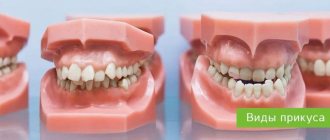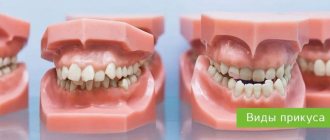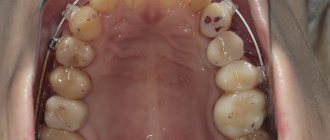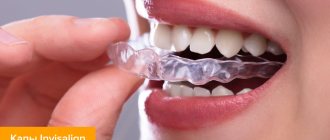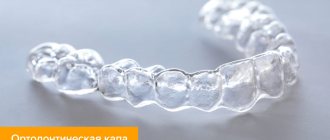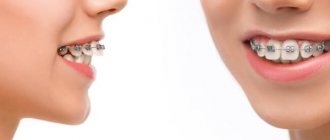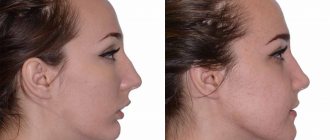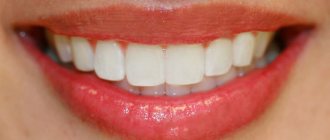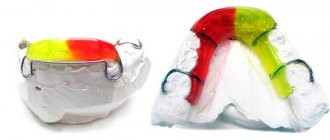How a bite is formed What a correct bite looks like Types Definition of a bite Possible consequences Methods of correction
Teeth bite is the relative arrangement of the dentition when the jaws are completely closed.
The formation of the dental system begins in intrauterine development. By the 11th week, the fetus has jaw stripes. Almost all children are born with malocclusion. The lower jaw is moved back. Dentists call this phenomenon retrognathia. When a baby actively sucks, the muscles are trained. By 6-8 months with breastfeeding, and a little later, with artificial feeding, the lower jaw takes the correct position. For bottle-fed children, it is necessary to monitor the position of the body and the hole in the nipple. If the formula does not flow from the bottle, you have to make an effort to get it, the child’s tongue and jaw muscles receive sufficient stress and malocclusions can be avoided.
Stages of bite formation
The first stage is completed by the time teeth erupt. Then it is formed:
- Temporary bite
Period: from 6 months to 3 years
. Teeth are actively growing, their relationship in the jaw is changing. When all the teeth have erupted, the stage of a formed temporary bite begins. It lasts until the moment when baby teeth begin to be replaced by permanent ones. The number of teeth is 20. Their location is influenced by the child’s habits: thumb sucking, sucking a corner of a bedspread, long-term use of a pacifier. Most causes of pathologies appear at this age.
- Replaceable (mixed)
Period: 6-14 years
. The active growth of permanent teeth increases the bite and promotes changes in the position of the jaw relative to each other. The jaws are in the process of formation. This is the ideal time for orthodontic treatment.
- Constant
Once all the baby teeth have fallen out, the bite becomes permanent. Number of teeth 28-32. With the appearance of fangs, the bite increases again.
The final formation of the jaws is completed by the age of 21, but the movement of teeth continues throughout life. The teeth are worn down by the friction of the side parts, because of this their position in the jaw changes, although we do not notice it. Dentists call this process mesial movement.
Correct bite with surgical treatment
It is also necessary to mention a rarer method - direct surgery. Sometimes achieving the perfect smile with the correct bite requires a little more than simply correcting the bite with braces or aligners. For example, when a change is required at the level of the entire jaw. We don’t always resort to surgery, but, again, sometimes the only option is to somehow influence the size and relative position of the jaws.
When performing surgical intervention, more stable results are achieved, but!
Surgical treatment of malocclusion has a number of serious disadvantages.
Firstly, this is an operation, most often under general anesthesia, with all the associated risks.
Secondly, other consequences are possible, for example, a change in the sensitivity of the mouth, or the appearance of defects in the bone tissue or gums in the future. But we, doctors, warn the patient in advance about possible risks and carefully discuss everything. Fortunately, for the vast majority of ordinary people, simpler ways to get your bite in shape are enough to correct your bite.
Thirdly, as a last resort, don’t bring your teeth to such a state that you may need not just surgical intervention, but total implantation.
What does a correct teeth bite look like?
Physiological (correct) occlusion in humans is characterized by:
- adequate form of dentition. The top one looks like a semi-ellipse, the bottom one resembles a parabola;
- the upper incisors overlap the lower ones by ⅓ of the height;
- there is contact between all teeth;
- the lower teeth are vertical, the upper teeth are inclined;
- each tooth, except 4, has 2 antagonists (one opposite);
- the correct bite in the diagram is marked by the symmetry of the incisors;
- chewing teeth are in contact with each other.
Correct bite in adults has its own variations. All of them are considered a variant of the norm:
- Orthognathic
. The upper teeth slightly overlap the lower teeth, and all molars and premolars occlude. - Straight
. The upper teeth do not overlap the lower ones, but join with them. The lateral teeth meet well. - Physiological progeny
. The lower teeth protrude beyond the upper teeth, but contact is maintained. The lateral teeth close together without gaps. - Biprognathic
. The incisors of both jaws are inclined forward, with intact contact.
How does the procedure work?
Structural occlusion serves as the basis for drawing up an orthodontic correction plan, within which the use of various types of devices that differ in functional and design characteristics is allowed. Such devices include:
- Elastic mouthguards for fixation;
- Plates placed on one of the dentitions;
- Piece rings and strips;
- Double-sided devices.
A common method of treatment is the Hotz technique, which involves controlling the eruption of dental elements using surgical extraction. However, it must be taken into account that this method requires long-term observation by a dentist, the end of which coincides with the period of the final formation of permanent units. To achieve the desired result, it is allowed to remove temporary elements, as well as teeth that have undergone pathological destruction, which is accompanied by traumatic intervention.
An alternative solution is to install braces, which eliminate surgery and provide a similar result. The duration of wearing orthodontic correctors turns out to be shorter - no more than 1.5-2 years, however, throughout the entire cycle the patient will have to put up with the presence of a foreign structure in the oral cavity, noticeable when communicating with others.
Other types of occlusion in dentistry
There are 3 large groups of bites.
- Normal
(physiological). These bites have several variations, but the teeth are closed, the jaws are in the correct position, and the teeth are symmetrical along the incisors. - Anomalous
. Congenital defects caused by harmful effects on the fetus during pregnancy or genetic disorders - Pathological
. Defects acquired after teething as a result of disease, missing units, or displacement of teeth.
In life, the last two concepts are often mixed and replace each other. Based on the relationship between teeth and jaws, the following types of bite are distinguished:
Deep
The upper teeth cover the upper ones by more than ⅓. The contact between the teeth is broken. This leads to impaired chewing function, abnormal enlargement of the upper jaw, and disruption of the anatomical structure of the face. The second name for this defect is traumatic. As a result of pathology, the functioning of the temporomandibular joint is often disrupted, the mucous membranes are injured, and the enamel is pathologically erased. This is the most common pathology.
Open
The teeth do not close completely. The defect can be frontal or lateral. This pathology is characterized by impaired diction, chewing, and swallowing. Mouth breathing is observed, hence drying out of the mucous membrane and frequent caries.
Distal
With this defect, the upper jaw is strongly pushed forward. The front teeth do not occlude, and the occlusion of the rear teeth is broken. Characterized by problems with breathing, chewing, and swallowing. Patients complain of joint pain, frequent caries, and periodontal disease.
Mesial
When the lower jaw is pushed forward, they speak of progeny or mesial occlusion. This jaw bite pathology is accompanied by diastemas (large gaps between the front teeth) or trema (gaps between any teeth). Often patients have crooked lower teeth, they are crowded, and there is increased deposit of tartar.
Crossbite
Some units overlap each other. Difficult to treat, surgical intervention is often used. It is characterized by facial deformation, speech defects, disruption of chewing function and the functioning of the TMJ. Patients complain of constant biting of the cheeks and tongue.
All pathological forms of bites in orthodontics are recommended for correction with removable (for baby teeth) and non-removable structures (braces), and aligners.
Determination methods
In orthodontics, the determination of constructive occlusion is carried out by creating model impressions. A precise orthodontic treatment plan is developed in advance. The template is made by moving the person's lower or upper jaw back and forth or to the side. Depending on the existing pathology, the required position of jaw occlusion is imprinted on the cast, and individual correction devices are manufactured.
There are several research methods:
- Pon's method - determination of the individual norm of the width of the dental arches.
- Snagina's method. A prerequisite for diagnosing pathologies of the width of the dentition is the presence of all dental elements and a correctly cast prototype.
- The Nance method is a measurement of the degree of shortening of the dental arch along the occlusal plane.
The dentist selects the optimal technique depending on the existing pathology.
How does the procedure work?
A wax base is created on a plaster model of the upper jaw with an occlusal ridge above the dentition. Under the strict control of the dentist, the patient moves the lower jaw forward with a distal bite or moves it back with a mesial displacement. Movement is carried out until the first permanent molars are neutral.
During the procedure, it is important to prevent muscle overstrain. The advancement of the lower jaw should occur in stages.
As a result of the patient's actions, the lateral teeth become separated in the vertical direction. Impressions of the lower row of teeth remain on the occlusal ridge of the soft wax base.
The jaw models are positioned and secured in the position of the obtained constructive bite and are plastered in the occluder.
Price
The price of making a wax template with bite ridges to determine a constructive bite varies from 300 to 2000 rubles. The indicated cost includes the diagnostic stage: taking an impression, creating and analyzing a diagnostic model, drawing up a treatment plan.
Determination of dental occlusion
Often problems with bite are obvious, but it also happens that everything looks normal on the outside, but there is a problem. Therefore, it is better to entrust the determination of the bite to the dentist. They use special methods to determine correct or incorrect bite and prescribe treatment.
Diagnostics include:
- Clinical examination
The orthodontist collects anamnesis, conducts a general examination and examines the oral cavity and nasopharynx. They examine breathing, speech formation, swallowing, chewing, biting.
- X-ray examination
A panoramic X-ray or CT scan allows you to identify skeletal abnormalities, see the exact location of the teeth, the condition of the roots, and bone tissue.
- Biometric test
The doctor examines the jaws, takes and records all measurements.
- Functional test
Examination in a stationary position, while talking, opening the mouth in the lateral and frontal projection.
It is impossible to put the jaw back in place on your own, but the sooner the intervention begins, the better the result. It is very difficult to restore the correct position of teeth after 25 years; it is better to do this while the bite is forming.
Correct bite with external braces
The first way to correct an overbite is with braces. Metal brackets that are fixed to the outside of the teeth. The technology is over 110 years old and is quite well developed. External braces offer a wide range of changes to the bite and provide a quick visual effect. Plus the price, especially in simple cases, is very affordable.
But, unlike more modern methods, such as aligners, braces have a number of obvious disadvantages:
- Any external braces are still visible, and this very often influences the choice by adults of one or another method of treating malocclusion.
- Braces contribute to the accumulation of plaque on the teeth, which means that oral hygiene is significantly reduced.
- Braces really rub the mucous membranes of the cheeks and lips, especially when starting orthodontic procedures.
- Restrictions are imposed on the patient in terms of eating solid foods.
- They often create significant psychological discomfort. Is correct bite worth such sacrifices on the part of an adult patient?
Today, the decision to correct the bite is treated with understanding, and braces no longer cause a smile. But still, the use of braces makes many people experience both physical and mental discomfort.
Consequences
The influence of bite on the condition of the dental system and the entire body is enormous.
Bite pathologies lead to:
- Loss of teeth. Uneven chewing load leads to cracks and chips. Bacteria penetrate through the damaged enamel layer, affecting periodontal tissue. Periodontitis develops. Teeth become loose and fall out. The risk of caries in such cases is higher than in people without defects.
- Disorders of the temporomandibular joint (TMJ). It begins to click, hurt, and in severe cases, dislocation is possible.
- Due to crowded teeth, plaque and tartar quickly form, which provokes gingivitis and periodontitis.
- Insufficient contact between teeth leads to food being poorly chewed. As a result, problems arise with the gastrointestinal tract.
- Oral, impaired breathing causes diseases of the respiratory system.
- The position of the jaws affects posture. An abnormal movement of the jaw forward shifts the center of gravity, the position of the neck changes, the chest collapses, and the person begins to stoop. Muscle tone is impaired and back pain begins.
- An incorrect bite distorts facial features and disrupts its symmetry.
Anomalies of the jaws affect the psychological state. The person withdraws into himself and avoids company. Depressive states are common.
Orthodontic treatment restores physical and emotional balance and helps improve self-esteem.
